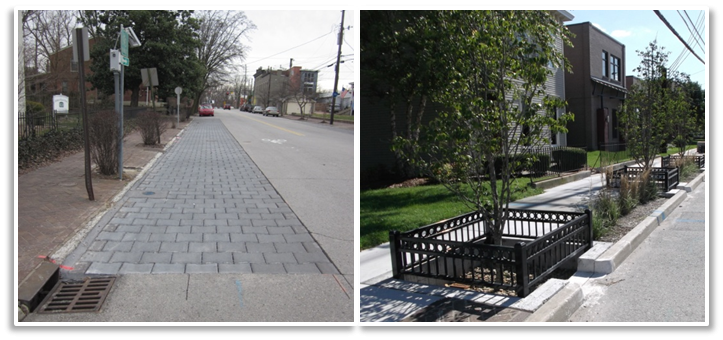Technical Assistance with Green Infrastructure
EPA is committed to helping local communities. EPA conducted a series of technical assistance projects focused on green infrastructure implementation. These projects will help other communities by sharing lessons learned.
Monitoring Green Infrastructure in Ohio and Kentucky

In Cincinnati, Ohio, EPA scientists and the U.S. Geological Survey (USGS) monitor green infrastructure pilot projects with the City. Researchers are tracking water quality and flow patterns, which will give them a better understanding of the efficiency of each practice. The pilot studies include the following locations and green infrastructure:
- Rain gardens at the St. Francis Court Apartments
- Permeable parking lots at Cincinnati State Technical and Community College
The Metropolitan Sewer District of Louisville, Kentucky is working with EPA scientists to develop a monitoring plan. It will demonstrate the performance of individual green infrastructure controls and the joint effectiveness of combined sewer flow control.
Guiding Green Infrastructure in Omaha
Like many older cities across the country, Omaha, Nebraska has a combined sewer system. During heavy rains, this sewage can overflow untreated into nearby water bodies, threatening human health and the environment. With the City and the Nebraska Department of Environmental Quality, EPA scientists are analyzing soils and preparing monitoring equipment to help the city add in green infrastructure to prevent overflows. Once locations are chosen for green infrastructure installations, EPA researchers are working with USGS to monitor water flow before and after installation to determine how well the green infrastructure performs.
Transforming Cleveland’s Vacant Lots in Cleveland, Ohio
Based on technical guidance from EPA experts, Cleveland, Ohio has added a green infrastructure pilot program to their combined sewer overflow (CSO) control plan. This program uses the city’s excess vacant land. The land is turned into green spaces that can soak up stormwater and keep excess water out of the sewer system. The transformations of urban vacant lots into park-like gardens that catch stormwater runoff not only help remedy the CSO problem, but also improve the social and economic fabric of neighborhoods lacking green spaces.
- Science Matters: Straightening the Road to Reuse - Connections between Demolition and Green Infrastructure
- Around the Water Cooler: Helping Cleveland Communities
- On the Road to Reuse: Residential Demolition Bid Specification Development Tool - September 2013 (PDF) (81 pp, 4 Mb, About PDF)
- Fact Sheet: On the Road to Reuse - September 2013 (PDF) (2 pp, 435 K, About PDF)
Daylighting Streams to Improve Water Quality
Researchers are comparing the effectiveness of buried streams versus daylighted streams for removing harmful nitrogen—buried streams are streams that have rerouted into underground pipes during urban development, daylighted streams are open-air streams. Early research results show that buried streams are less effective than daylighted streams. This suggests that turning buried streams into daylighted streams could prove a sustainable method for nitrogen removal and improved water quality.
EPA researchers will use the outcomes of this study and further research to make a modeling tool that will help urban managers determine where daylighting streams would be most effective.
Around the Water Cooler: Showing Buried Streams the Daylight
Additional Information:
- Greening CSO Plans: Planning and Modeling Green Infrastructure for Combined Sewer Overflow (CSO) Control (PDF) (38 pp, 1.9 MB, About PDF). This technical resource assists communities in developing and evaluating CSO control alternatives that include green infrastructure.
- EPA's Stormwater Management and Green Infrastructure Research
- EPA's information on Green Infrastructure
